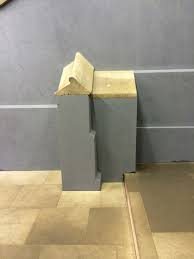 The Absolute Essentials
The Absolute Essentials
 The Eton Fives Court
The Eton Fives CourtThis is where the game originated. Whilst there is now an official standard court design, many courts in existence vary in terms of dimensions and detail, but all of them have the same, rather unusual, features. The court is divided into two parts, separated by a step, which is positioned about 1/3 of the length of the court from the front wall. The front part of the court is variously known as the front or upper (up) court, or top step (we will use the term 'front court'). Because of the step, the front court is a few inches higher than the rear part, which is known as the back, down or lower court (we will call it the 'back court'). The end of the back court is defined by another small step.
Whilst there are no actual rules about where the players must stand during a game - except during the service - it is usual for two players (one from each team) to be in the front court, whilst their partners play in the back court, although any player may play a shot in either court during the course of a game.
The Walls
 The Buttress
The ButtressThe buttress is very complex in shape, with many slopes and angles. Where the buttress meets the step it forms a small three-sided niche, called "the dead-man's hole" or just "the hole". This is a natural place to try to send the ball when playing, as it often results in an unreturnable shot. However, because it is very small, it requires great accuracy to successfully "kill" a ball in the hole.
As can be imagined, the design of the court, with its profusion of surfaces and angles, adds marvellous complexity to the game. Skilful players make great use of the features - especially the buttress - to confuse and deceive their opponents. Simple shots often become unpredictable ricochets. The front court is particularly difficult to play in, as the ball may easily change direction several times during its travel.
Eton Fives is an extremely fast game, but it is also a game of great skill: players practised in its subtleties and nuances will nearly always beat those who rely mainly on brute force and speed. Perhaps uniquely amongst ball games, the court's peculiarities of design are considered to give left-handed players an advantage over right-handed ones. The amibidextrous, naturally, have a huge advantage over both, since shots may be played with either hand.
CLICK HERE to watch the game being played

